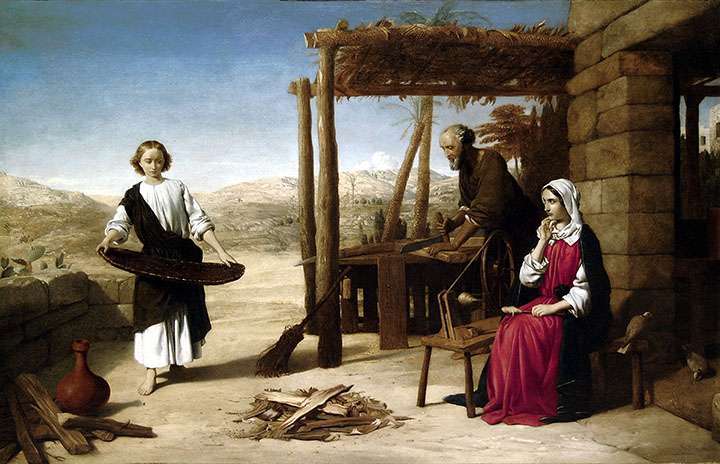Symbolism is a rich tradition in religious art that enhances the viewer’s understanding of the metaphorical meaning in an artwork. Take a moment to look at the main figures in Our Saviour Subject to His Parents at Nazareth. What do you think the young Christ is gazing at? What is he in the process of doing? Now look at Adoration of the Shepherds and notice the Christ child’s resting place on an elevated slab covered by a large white sheet. Might this reference a specific Christian ordinance? These seemingly normal elements of the painting are functional but also allude to many salient characteristics of religious doctrine and Christ’s divinity. A contemporary work such as Ron Richmond’s Exchange No. 8 completely eliminates the use of animate objects. What messages do you think are being conveyed through the colors, shapes, lines, and forms in this piece?
John Rogers Herbert (1810–1890) Our Saviour Subject to His Parents at Nazareth
Purchased with funds provided by Jack R. and Mary Lois Wheatley

Eustache Le Seur (1616–1655) Adoration of the Shepherds
Purchase/gift of Gloria Teichert with funds provided by Jack R. and Mary Lois Wheatley

YOU MAY NOTICE
In Our Saviour Subject to His Parents at Nazareth, the two birds near the doorway probably refer to the pair of two young pigeons sacrificed when Jesus was presented at the temple as an infant. Christ’s flat winnowing basket suggests the sifting of wheat from the chaff, and the red jug in the corner foreshadows his first miracle of turning water into wine.
In Adoration of the Shepherds, the small Christ child is draped in a large white cloth which references the fabric covering the dead body of Christ in the tomb. The ruins may refer to Christ’s fulfillment of the Mosaic law, which has now been superseded by a higher law.
The white and red cloths covering the chairs in Exchange No. 8 refer to Isaiah’s prophesy that sins once “as scarlet…shall be as white as snow…” (Isaiah 1:18). Notice that the chair with the white sheet is positioned vertically, pointing toward heaven, while the red chair is knocked over and creates a long horizontal line that grounds the composition. The work is contained within the shape of concentric squares, all even in dimension and often representative of materiality and the four cardinal directions of the earth. A lightly stenciled circle seems to lie within the square’s even borders, representative of the eternal heavenly realm.
